John II of Portugal
Last updated| John II | |
|---|---|
 Portrait of John II at the Navy Museum | |
| King of Portugal | |
| Reign | 28 August 1481 – 25 October 1495 |
| Acclamation | 31 August 1481, Sintra |
| Predecessor | Afonso V |
| Successor | Manuel I |
| Reign | 11 November 1477 – 15 November 1477 |
| Acclamation | 11 November 1477, Santarém |
| Predecessor | Afonso V |
| Successor | Afonso V |
| Born | 3 March 1455 Saint George's Castle, Portugal |
| Died | 25 October 1495 (aged 40) Alvor, Algarve |
| Burial | |
| Spouse | |
| Issue Detail |
|
| House | Aviz |
| Father | Afonso V of Portugal |
| Mother | Isabella of Coimbra |
John II (Portuguese : João II; [1] [ʒuˈɐ̃w] ; 3 March 1455 – 25 October 1495), called the Perfect Prince (Portuguese: o Príncipe Perfeito), was King of Portugal from 1481 until his death in 1495, and also for a brief time in 1477. He is known for re-establishing the power of the Portuguese monarchy, reinvigorating the Portuguese economy, and renewing his country's exploration of Africa and Asia.
Contents
Early life
Born in Lisbon, the son of King Afonso V of Portugal by his wife, Isabella of Coimbra, John II succeeded his father as ruler of Portugal in 1477, when the king retired to a monastery, but only became king in 1481, after the death of his father and predecessor.
As a prince, John II accompanied his father in the campaigns in northern Africa and was made a knight after the victory in the Conquest of Arzila in 1471. In 1473, he married Leonor of Viseu, an infanta of Portugal and his first cousin.
Even at a young age, John was not popular among the peers of the kingdom since he was immune to external influence and appeared to despise intrigue. The nobles (including particularly his half second cousin Ferdinand II, the Duke of Braganza) were afraid of his future policies as king.
Consolidation of power

After his official accession to the throne in 1481, John II took a series of measures to curtail the power of the Portuguese aristocracy and concentrate power in himself. As one example of the measures he took, he deprived the nobles of their right to administer justice on their estates. [2] Immediately, the nobles started to conspire. Letters of complaint and pleas to intervene were exchanged between the Duke of Braganza and Queen Isabella I of Castile.
King John took the precaution of renegotiating the "Tercerias de Moura" agreement to insure that his son Afonso was living safely back at court before he would move against Braganza, the most powerful noble in the realm (the original agreement called for Afonso to live in Moura, Portugal, with his intended Spanish bride, Isabella, Princess of Asturias, as children before their marriage). [3] In 1483, additional correspondence was intercepted by royal spies. The House of Braganza was outlawed, their lands confiscated and the duke executed in Évora. The Duke's widow, Isabella of Viseu, John's cousin and sister-in-law, fled with her children to Castile. [4]
In the following year, the Duke of Viseu, John's cousin and brother-in-law, was summoned to the palace and stabbed to death by the king himself for suspicion of a new conspiracy. Many other people were executed, murdered, or exiled to Castile, including the Bishop of Évora, who was poisoned in prison. [2] Following the crackdown, no one in the country dared to defy the king and John saw no further conspiracies during his reign. A great confiscation of estates followed and enriched the crown, which now became the dominant power of the realm.
Economy
Facing a bankrupt kingdom, John II showed the initiative to solve the situation by creating a regime in which a council of scholars took a vital role. [4] The king conducted a search of the population and selected members for the council on the basis of their abilities, talents and credentials (meritocracy). John's exploration policies (see below) also paid great dividends. Such was the profit coming from John II's investments in the overseas explorations and expansion that the Portuguese currency had become the soundest in Europe. The kingdom could finally collect taxes for its own use rather than to pay debts, mainly thanks to its main gold source at that time, the coast of Guinea.
Exploration
John II famously restored the policies of Atlantic exploration, reviving the work of his great-uncle, Henry the Navigator. The Portuguese explorations were his main priority in government, patronising both national and foreign men, such as João Afonso de Aveiro and Martin Behaim, to further his goals. Portuguese explorers pushed south along the known coast of Africa with the purpose of discovering the maritime route to India and breaking into the spice trade. During his reign, the following achievements were realised:
- 1482 – Foundation of the coastal fortress and trade post of São Jorge da Mina
- 1484 – Discovery of the Congo River by Diogo Cão.
- 1488 – Discovery and passage of the Cape of Good Hope by Bartolomeu Dias in Mossel Bay. [5]
- 1493 – Start of the settlement of the São Tomé and Príncipe islands by Álvaro Caminha.
- Funding of land expeditions by Afonso de Paiva and Pêro da Covilhã to India and Ethiopia in search of the kingdom of Prester John.
The true extent of Portuguese explorations has been the subject of academic debate. According to one theory, some navigations were kept secret for fear of competition by neighbouring Castile. The archives of this period were mainly destroyed in the fire after the 1755 Lisbon earthquake, and what was not destroyed during the earthquake was either stolen or destroyed during the Peninsular War or otherwise lost. [6] [7] [8]
Conflict with Castile

When Columbus returned from his first voyage early in 1493, he first stopped in Lisbon to claim his victory in front of King John II. King John II's only response to this was that under the Treaty of Alcáçovas previously signed with Spain, Columbus's discoveries lay within Portugal's sphere of influence. Before Columbus even reached Isabella I of Castile, John II had already sent a letter to them threatening to send a fleet to claim it for Portugal. Spain quickly hastened to the negotiating table, which took place in a small Spanish town named Tordesillas with a papal representative present to act as mediator. The result of this meeting would be the famous Treaty of Tordesillas, which sought to divide all newly discovered lands in the New World between Spain and Portugal.
Legacy
John II died at Alvor at age 40 without legitimate children. Despite his attempts to have his illegitimate son Jorge, Duke of Coimbra, succeed him, he was succeeded by his first cousin and brother in-law, Manuel I.
The nickname the Perfect Prince is a posthumous appellation that is intended to refer to Niccolò Machiavelli's work The Prince . John II is considered to have lived his life exactly according to the writer's idea of a perfect prince. Nevertheless, he was admired as one of the greatest European monarchs of his time. Isabella I of Castile usually referred to him as El Hombre (The Man). [9]
The Italian scholar Poliziano wrote a letter to John II that paid him a profound homage:
- to render you thanks on behalf of all who belong to this century, which now favours of your quasi-divine merits, now boldly competing with ancient centuries and all Antiquity.
Indeed, Poliziano considered his achievements to be more meritorious than those of Alexander the Great or Julius Caesar. He offered to write an epic work giving an account of John II accomplishments in navigation and conquests. The king replied in a positive manner in a letter of 23 October 1491, but delayed the commission. [10]
In popular culture
- In the TV series Christopher Columbus (1985) he is played by Max von Sydow.
- In the film Christopher Columbus: The Discovery (1992) he is played by Mathieu Carrière.
- He appears in Civilization IV (as João II), leading the Portuguese.
- In the TV series Isabel played by Álvaro Monje
Marriage and descendants
| Name | Birth | Death | Notes |
|---|---|---|---|
| By Leonor of Viseu (2 May 1458 – 17 November 1525; married in January 1471) | |||
| Infante Afonso | 18 May 1475 | 13 July 1491 | Prince of Portugal. Died in a horse riding accident. Because of the premature death of the prince, the throne was inherited by Manuel of Viseu, Duke of Beja, son of Ferdinand, Duke of Viseu, who reigned as Manuel I, 14th King of Portugal. |
| Stillborn | 1483 | 1483 | Stillborn son, born in 1483. |
| By Ana de Mendonça (c. 1460-?) | |||
| Jorge [11] | 21 August 1481 | 22 July 1550 | Natural son known as Jorge de Lancastre, Duke of Coimbra. |
Ancestry
| Ancestors of John II of Portugal | ||||||||||||||||||||||||||||||||||||||||||||||||||||||||||||||||||||||||||||||||||||||||||||||||||||||||||||||||||||||||||||||||||||||||||||||||||||||||||||||||||||||||||||||||||||||||||||||||||||||||||||||||||||||||||||||||||||||||||||||||||||||||||||||||||||||||||||||||||||||||||||||||||||||||||||||||||||||||||||||||||||||||||||||||||||||||||||||||||||||||||||||||||||||||||||||||||||||||||||||||||||||||||||||||||||||||||||||||||||||||||||||||||||||||||||||||||||||||||||||||||||||||||||||||||||||||||||||||||||||||||||||||||||||||||||||||||||||||||||||||||||||||||||||||||||||||||||||||
|---|---|---|---|---|---|---|---|---|---|---|---|---|---|---|---|---|---|---|---|---|---|---|---|---|---|---|---|---|---|---|---|---|---|---|---|---|---|---|---|---|---|---|---|---|---|---|---|---|---|---|---|---|---|---|---|---|---|---|---|---|---|---|---|---|---|---|---|---|---|---|---|---|---|---|---|---|---|---|---|---|---|---|---|---|---|---|---|---|---|---|---|---|---|---|---|---|---|---|---|---|---|---|---|---|---|---|---|---|---|---|---|---|---|---|---|---|---|---|---|---|---|---|---|---|---|---|---|---|---|---|---|---|---|---|---|---|---|---|---|---|---|---|---|---|---|---|---|---|---|---|---|---|---|---|---|---|---|---|---|---|---|---|---|---|---|---|---|---|---|---|---|---|---|---|---|---|---|---|---|---|---|---|---|---|---|---|---|---|---|---|---|---|---|---|---|---|---|---|---|---|---|---|---|---|---|---|---|---|---|---|---|---|---|---|---|---|---|---|---|---|---|---|---|---|---|---|---|---|---|---|---|---|---|---|---|---|---|---|---|---|---|---|---|---|---|---|---|---|---|---|---|---|---|---|---|---|---|---|---|---|---|---|---|---|---|---|---|---|---|---|---|---|---|---|---|---|---|---|---|---|---|---|---|---|---|---|---|---|---|---|---|---|---|---|---|---|---|---|---|---|---|---|---|---|---|---|---|---|---|---|---|---|---|---|---|---|---|---|---|---|---|---|---|---|---|---|---|---|---|---|---|---|---|---|---|---|---|---|---|---|---|---|---|---|---|---|---|---|---|---|---|---|---|---|---|---|---|---|---|---|---|---|---|---|---|---|---|---|---|---|---|---|---|---|---|---|---|---|---|---|---|---|---|---|---|---|---|---|---|---|---|---|---|---|---|---|---|---|---|---|---|---|---|---|---|---|---|---|---|---|---|---|---|---|---|---|---|---|---|---|---|---|---|---|---|---|---|---|---|---|---|---|---|---|---|---|---|---|---|---|---|---|---|---|---|---|---|---|---|---|---|---|---|---|---|---|---|---|---|---|---|---|---|---|---|---|---|---|---|---|---|---|---|---|---|---|---|---|---|---|---|---|---|---|---|---|---|---|---|---|---|---|---|---|---|---|---|---|---|---|---|---|---|---|---|---|---|---|---|---|---|---|---|---|---|---|---|---|---|---|---|---|---|---|---|---|---|---|---|---|---|---|---|---|---|---|---|---|---|---|---|---|---|---|---|---|---|---|---|---|---|---|---|---|---|---|---|---|---|---|---|---|---|---|---|---|---|---|---|---|---|---|---|---|---|---|---|---|---|---|---|---|---|---|---|---|---|---|---|---|---|---|
| ||||||||||||||||||||||||||||||||||||||||||||||||||||||||||||||||||||||||||||||||||||||||||||||||||||||||||||||||||||||||||||||||||||||||||||||||||||||||||||||||||||||||||||||||||||||||||||||||||||||||||||||||||||||||||||||||||||||||||||||||||||||||||||||||||||||||||||||||||||||||||||||||||||||||||||||||||||||||||||||||||||||||||||||||||||||||||||||||||||||||||||||||||||||||||||||||||||||||||||||||||||||||||||||||||||||||||||||||||||||||||||||||||||||||||||||||||||||||||||||||||||||||||||||||||||||||||||||||||||||||||||||||||||||||||||||||||||||||||||||||||||||||||||||||||||||||||||||||
Notes
- ↑ Rendered as Joam in Archaic Portuguese
- 1 2 "Prestage, Edgar. "Portugal." The Catholic Encyclopedia. Vol. 12. New York: Robert Appleton Company, 1911. 30 Jul. 2014". Newadvent.org. Retrieved 26 August 2014.
- ↑ A History of Portugal, p. 213, CUP Archives. 19 January 1947. Retrieved 26 August 2014.
- 1 2 Busk, M. M. (1833). Busk, M.M., The History of Spain and Portugal from B.C. 1000 to A.D. 1814, p. 80, Baldwin and Cradock, 1833 . Retrieved 26 August 2014.
- ↑ Disney, A.R. (2009) A History of Portugal and the Portugal Empire, Volume 2: The Portuguese Empire: 38–39; Cambridge University Press: New York
- ↑ Charles E. Nowell (1936). "The Discovery of Brazil: Accidental or Intentional?". The Hispanic American Historical Review. 16 (3): 311–338. doi:10.2307/2507557. JSTOR 2507557.
- ↑ J. Baltalha-Reis (1897). "The Supposed Discovery of South America before 1488, and Critical Methods of the Historians of Geographical Discovery". The Geographical Journal. 9 (2): 185–210. doi:10.2307/1773506. JSTOR 1773506.
- ↑ Ilaria Luzzana Caraci (1988). Columbus and the Portuguese Voyages in the Columbian Sources. UC Biblioteca Geral 1. Retrieved 17 November 2010.
- ↑ McKendrick, Melveena (2000). Playing the king: Lope de Vega and the limits of conformity. Tamesis. p. 55. ISBN 9781855660694.
His cousin, Isabella of Castille, herself no weakling, admiringly dubbed him 'el Hombre', for all the world like some early spaghetti-western hero.
- ↑ Manuel Bernardes Branco (1879). Portugal e os Estrangeiros. Lisboa: Livraria de A.M.Pereira. pp. 415–417. (Translation of the latin by Teófilo Braga) "render-vos graças em nome de todos quantos pertencemos a este século, o qual agora, por favor dos vossos méritos quasi-divinos, ousa já denodadamente competir com os vetustos séculos e com toda a antiguidade."
- ↑ Livermore 1976, p. 132.
- 1 2 3 4 Stephens, Henry Morse (1903). The story of Portugal. G.P. Putnam's Sons. pp. 125, 139. ISBN 9780722224731 . Retrieved 11 July 2018.
- 1 2 Afonso V, King of Portugal at the Encyclopædia Britannica
- 1 2 "Leonora of Aragon (1405–1445)". Women in World History: A Biographical Encyclopedia. Gale Research. Retrieved 11 July 2018.
- ↑ Pedro, 1o duque de Coimbra at the Encyclopædia Britannica
- 1 2 3 Ryder, Alan (2007). The Wreck of Catalonia: Civil War in the Fifteenth Century . Oxford University Press. p. 152. ISBN 978-0-19-920736-7.
Related Research Articles

Afonso V, known by the sobriquet the African, was king of Portugal from 1438 until his death in 1481, with a brief interruption in 1477. His sobriquet refers to his military conquests in Northern Africa.

The history of the Kingdom of Portugal from the Illustrious Generation of the early 15th century to the fall of the House of Aviz in the late 16th century has been named the "Portuguese golden age" and the "Portuguese Renaissance". During this period, Portugal was the first European power to begin building a colonial empire as during the Age of Exploration Portuguese sailors and explorers discovered an eastern route to India as well as several Atlantic archipelagos and colonized the African coast and Brazil. They also explored the Indian Ocean and established trading routes throughout most of southern Asia, sending the first direct European maritime trade and diplomatic missions to Ming China and to Japan, at the same time installing trading posts and the most important colony: Portuguese Macau. The Portuguese Renaissance produced a plethora of poets, historians, critics, theologians, and moralists. The Cancioneiro Geral by Garcia de Resende is taken to mark the transition from Old Portuguese to the modern Portuguese language.
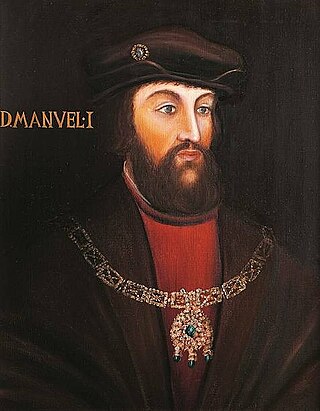
Manuel I, known as the Fortunate, was King of Portugal from 1495 to 1521. A member of the House of Aviz, Manuel was Duke of Beja and Viseu prior to succeeding his cousin, John II of Portugal, as monarch. Manuel ruled over a period of intensive expansion of the Portuguese Empire owing to the numerous Portuguese discoveries made during his reign. His sponsorship of Vasco da Gama led to the Portuguese discovery of the sea route to India in 1498, resulting in the creation of the Portuguese India Armadas, which guaranteed Portugal's monopoly on the spice trade. Manuel began the Portuguese colonization of the Americas and Portuguese India, and oversaw the establishment of a vast trade empire across Africa and Asia.
The Battle of Alfarrobeira took place on 20 May 1449. It was a confrontation between the forces commanded by King Afonso V of Portugal and his uncle Afonso, Duke of Braganza, against the army of the rebellious Peter, Duke of Coimbra. The place was Vialonga, near Lisbon, at the margins of the creek of Alfarrobeira. The result was the clear defeat and death of the Duke of Coimbra and the establishment of the Braganzas as the most powerful House of Portugal.

Afonso, Hereditary Prince of Portugal was the heir apparent to the throne of Portugal. He was born in Lisbon, Portugal, and died in a horse-riding accident on the banks of the river Tagus.

The Most Serene House of Braganza, also known as the Brigantine dynasty, is a dynasty of emperors, kings, princes, and dukes of Portuguese origin which reigned in Europe and the Americas.

The House of Aviz, also known as the Joanine Dynasty, was a dynasty of Portuguese origin which flourished during the Renaissance and the period of the Portuguese discoveries, when Portugal expanded its power globally.
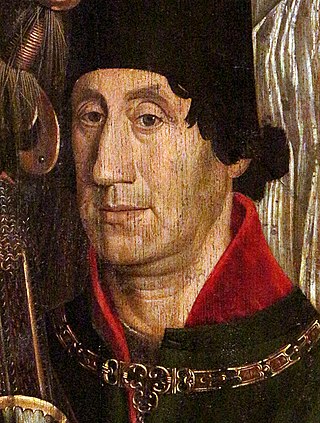
Dom Peter, Duke of Coimbra, KG, was a Portuguese infante (prince) of the House of Aviz, son of King Dom John I of Portugal and his wife, Philippa of Lancaster, daughter of John of Gaunt. In Portugal, he is known as Infante Dom Pedro das Sete Partidas [do Mundo], "of the Seven Parts [of the World]" because of his travels. Possibly the best-travelled prince of his time, he was regent between 1439 and 1448. He was also 1st Lord of Montemor-o-Velho, Aveiro, Tentúgal, Cernache, Pereira, Condeixa and Lousã.
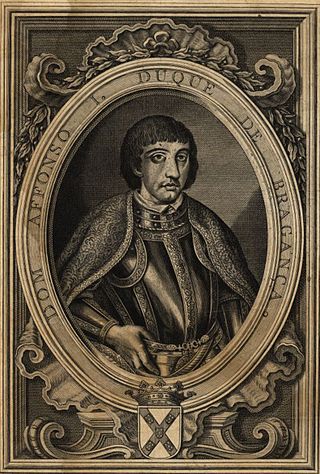
Dom Afonso I of Braganza was the first duke of Braganza and the eighth count of Barcelos. He founded the House of Braganza, the most powerful and wealthy dynasty in Portugal. His descendants became high-ranking nobles, imperial officials, and finally kings of Portugal and emperors of Brazil.
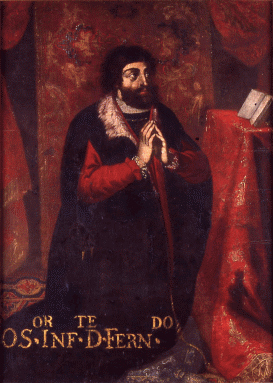
Infante Ferdinand, Duke of Viseu and Beja was the third son of Edward, King of Portugal and his wife Eleanor of Aragon.
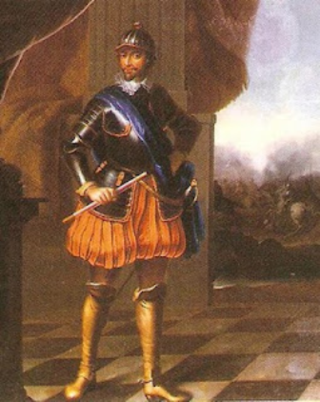
Dom Fernando II of Braganza was the 3rd Duke of Braganza and the 1st Duke of Guimarães, among other titles. He is known for being executed for treason against the King.
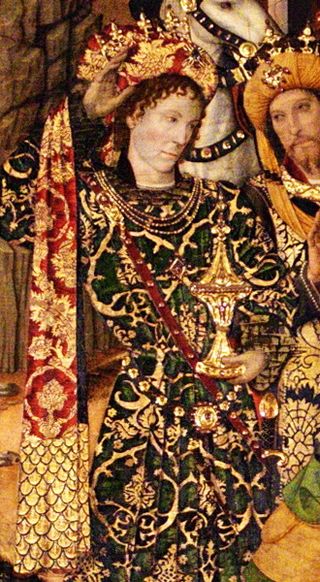
Peter of Coimbra, sometimes known as Peter V of Aragon, was the son of Infante Peter, Duke of Coimbra, who became the fifth Constable of Portugal and third Grand Master of the Order of Saint Benedict of Aviz. The Consell de Cent later granted Peter the Crown of Aragon, which he claimed from 1463 to 1466 in opposition to John II. His status as king of Aragon, however, along with that of John II's other challengers, is disputed.

Infanta Beatriz of Portugal was a Portuguese infanta, daughter of John, Constable of Portugal, and Isabella of Barcelos, a daughter of Afonso I, Duke of Braganza.

Isabella of Urgell, Duchess of Coimbra was a Catalan noblewoman of the Urgell branch of the House of Barcelona. She was the wife of Infante Peter, Duke of Coimbra.

Isabel of Viseu (1459–1521) was a daughter of Infante Fernando, Duke of Viseu and his wife and cousin Infanta Beatrice, Duchess of Viseu. She was a member of the House of Aviz and later, House of Braganza.
Álvaro of Braganza was the 4th son of Ferdinand I, 2nd Duke of Braganza and his wife, Dona Joana de Castro.

Isabella of Portugal (1364–1395) was the natural daughter of King Ferdinand I of Portugal, from an unknown mother.

João of Braganza, born ca. 1430, was the second son of Fernando I, Duke of Braganza and of his wife, the duchess Joan of Castro.
The Ínclita Geração is a term commonly used by Portuguese historians to refer to a group of 15th-century infantes (princes) of the House of Aviz, specifically the sons of King John I of Portugal and his wife Philippa of Lancaster : the future king Edward of Portugal; the future regent Peter of Coimbra; Prince Henry the Navigator; the constable John of Reguengos; and the martyr Ferdinand the Holy Prince.
In the Medieval Kingdom of Portugal, the Cortes was an assembly of representatives of the estates of the realm – the nobility, clergy and bourgeoisie. It was called and dismissed by the King of Portugal at will, at a place of his choosing. Cortes which brought all three estates together are sometimes distinguished as Cortes-Gerais, in contrast to smaller assemblies which brought only one or two estates, to negotiate a specific point relevant only to them.
References
- Bodian, Mirian (1997). Hebrews of the Portuguese Nation.
- Boxer, Charles R. (1991). From Lisbon to Goa, 1500–1750.
- Boxer, Charles R. (1969). The Portuguese Seaborne Empire 1415–1825.
- Duffy, James (1968). Portuguese Africa.
- Livermore, H.V. (1976). A New History of Portugal. Cambridge University Press.
- Mira, Manuel S. (1998). Forgotten Portuguese: The Melungeons and the Portuguese Making of America.
- Orange, G. V. (June 1968). "King John II of Portugal and the Quest for India". History Today. Vol. 18, no. 6. pp. 415–421.
- Page, Martin. The First Global Village.

